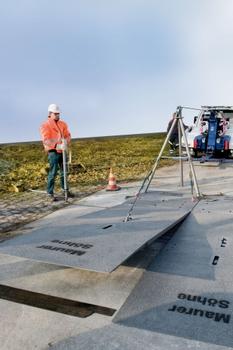Simply Bridging the Gap
The cause for this new development were the high costs for setting up a job site when expansion joints have to be replaced – and this in connection with high penalties when the replacement period and thus the time of blocking the traffic is exceeded. Conventional systems are too bulky and can be only established with the help of expensive mobile cranes. MMBS will be delivered with an efficient transporter. One side will be anchored firmly in the ground, and the other side will be swung open or closed. The bridging capacity is a structural gap of up to 2.2 m width.
Efficient modular system
The new bridging system attains its flexibility by way of its modular structure. The individual elements can be produced in various widths according to the requirements of the customer. When placed next to each other, they very fast constitute an interim bridge which can be passed by up to 70 km/h.
Even much faster the change to the job site operation can be accomplished and back again to flowing traffic. The bridge side is simply pulled up with the help of a bowden cable and then being stabilized in upright position. By way of its modular structure it is possible to foresee only parts of the bridge for job site operations or for passing traffic.
MMBS is being made of steel, and as a substitute for an expansion joint also accommodates thermic and dynamic displacements in longitudinal direction of the bridge. The system was developed especially for the replacement of expansion joints, and it was first time implemented at the Fallington Viaduct at the A3(M) in Southern England, from February to April 2011. Very early it turned out that this system draws also interest for other types of jobs at roads, like for example when working on canals and ducts.
Structure Types
- About this
data sheet - Product-ID
3617 - Published on:
30/04/2012 - Last updated on:
19/05/2017



 MAURER SE
MAURER SE 